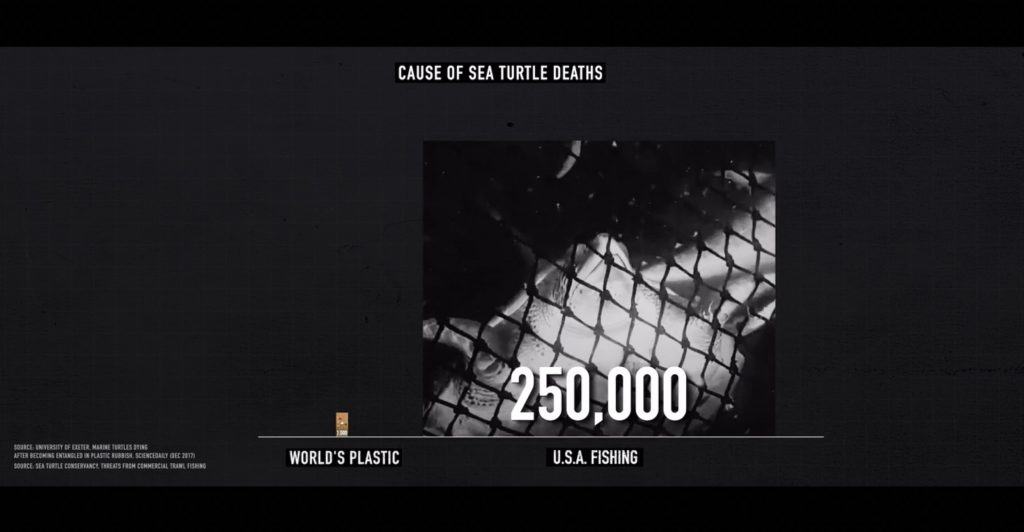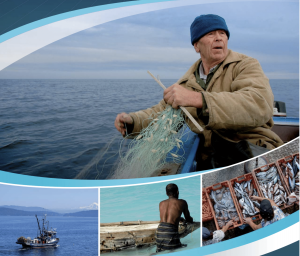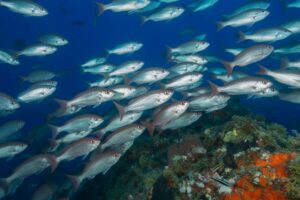Originally published in Sustainable Fisheries. Author Emily De Sousa
The talk of the ocean world is Seaspiracy, a Netflix Original film produced by the same team responsible for Cowspiracy and What the Health. Like those two previous films, Seaspiracy is full of misinformation and has been panned by actual experts.
Others have already addressed the racist and xenophobic undertones of the film, the egregious amount of time spent trying to weasel non-profit organizations into “gotcha” moments, the misrepresentation of their interview guests, and the general lack of integrity by the filmmakers to telling true stories.
This post will focus on addressing the misinformation presented in the film. Though I share the filmmaker’s passion for the oceans, our integrity and commitment to telling the truth are very different.
Misinformation: The oceans will run out of fish by 2048.
Truth: Monitored fish populations (representing over half of the world’s catch) are, on average, increasing in abundance and have been for years.
Every time the 2048 myth is repeated, part of a fisheries scientists’ soul dies.
It comes from a 2006 paper that misconstrued a finding in its press release. Journalists ran with the memorable number and, despite the fact that dozens of follow up papers and the original authors themselves have updated the data, the scourge persists.
It was an important moment in fishery science when the original authors collaborated with a larger group of scientists to build out a more extensive data set for a 2009 paper which showed, on average, no downward trend for global fisheries. While their predictions had some stocks declining, they also showed areas where stocks were not predicted to be overfished and other areas where stocks would increase after reducing fishing pressure.
Indeed, that same data set was updated again last year. Even further progress has been made over the last decade: monitored fish populations around the world, representing over half of all catch, are generally healthy or increasing.
So no, the ocean will not run out of fish by 2048. That statistic is not scientifically accepted and should stop being cited.

Misinformation: Up to 40% of catch gets thrown back as bycatch.
Truth: 10% has been discarded at sea over the past decade.
This is another statistic that is commonly cited but untrue. From a previous UW Sustainable Fisheries post:
The global authority on world fisheries, the United Nations Food and Agriculture Organization (FAO), defines bycatch as, “the total catch of non-target animals.” This is the widely accepted definition.
Bycatch can be a useful indicator of fishery impacts on the broader ecosystem and provides important data that fishermen and fishery managers use to improve sustainability. Different fisheries have different rates of bycatch with varying degrees of impact. However, an important nuance is that bycatch is used or discarded. Used bycatch is generally accepted as sustainable so long as the non-target species isn’t a threatened species. Discards are wasteful and an unfortunate reality of food production. The most recent research showed that about 10% of fish have been discarded at sea over the past decade.
So how did 10% get inflated to 40%?
In 2009, three people working for NGOs (World Wildlife Fund & Dorset Wildlife Trust) and one unaffiliated person decided to write a paper arguing that the definition of “bycatch” needed to be redefined to include ALL catch from unmanaged fisheries. From their paper:
The new bycatch definition is therefore defined in its simplest form as: “Bycatch is catch that is either unused or unmanaged.”
The authors define “unmanaged” as catch that “does not have specific management to ensure the take is sustainable;” in contrast, a managed fishery will have “clearly defined measures specifically intended to ensure the sustainable capture of any species or groups of species within any fishing operation.” An example they gave in the paper is that, because a 1993 study showed that members of the Indian bottom trawling fleet used nets with illegal mesh, “such a fishery cannot be considered managed, as defined in this paper, [thus] the entire catch of the Indian bottom trawl fleet is considered bycatch.” By their definition, they calculated 56.3% of India’s total catch as bycatch.
Adding up all this calculation for each country brought them to declare 40.4% of the world’s catch as bycatch.
No serious scientist or organization counts unmanaged catch as bycatch—it is a ridiculous thing to conflate. Discards are what matters—10% is the more informative number to cite.

Misinformation: 250,000 sea turtles are killed as a result of bycatch in the U.S. every year.
Truth: The most recent study estimates that 4,600 sea turtles are killed each year in the U.S.
Yet another misleading statistic from a 17-year old, outdated study that used data from the year 2000. More recent science (from the same authors as the 17-year old study) shows that sea turtle deaths resulting from fishing are down over 94%, primarily due to turtle excluder devices (TEDs) and other bycatch-reducing technology being introduced over the past few decades.
Another recent study shows that sea turtle populations have increased significantly.
Misinformation: 46% of plastic in the ocean is from fishing nets.
Truth: BY WEIGHT, 46% of plastic in the Great Pacific Garbage Patch (GPGP) was estimated to be from fishing nets. There is some serious nuance here involving how much plastic floats vs. sinks.
Plastic in the ocean is a terrible problem, but the way it is presented, and the lack of scientific understanding is a significant flaw and actively hurts efforts to reduce plastic waste; here’s why:
In 2018, a major paper was published on plastic pollution in the Great Pacific Garbage Patch. It was the most comprehensive plastic survey ever done—researchers flew planes over the garbage patch to survey debris and ran several net-tows to collect samples. From their surveying and sampling data, they estimate that trillions of pieces of plastic are swirling around in the Great Pacific Garbage Patch. Of those trillions of pieces, megaplastics (larger than 50cm) make up less than .0002% of individual pieces. Of those, some are fishing nets.
By weight, it is a different story. The researchers estimate that fishing nets comprise 46% of the weight of floating plastic in the garbage patch. From the paper:
Despite an increase in the GPGP mass estimate, a great discrepancy between predicted and observed ocean plastic concentrations remains. Considering currently accepted plastic inputs from land- and marine-based sources, our global model predicted millions of tonnes of ocean plastic to be within the GPGP region, while we only found tens of thousands of tonnes. This two-orders of magnitude difference suggests the existence of mechanisms removing most of the plastic mass from the sea surface.
Basically, the vast majority of the plastic that enters the ocean sinks. Of the plastic that doesn’t sink, fishing nets are estimated to be 46% of the mass. Though fishing nets can sink, I suspect they are probably over-represented in the floating debris as many nets contain floatation buoys. If anything, fishing nets should be the most accessible type of plastic to remove from the ocean.
Misinformation: Fisheries observers and boat captains are corrupt and often lie about how much fish is caught.
Truth: Lying about catch data is highly illegal and results in stripping a fisherman’s license. Few fishermen gamble with their livelihood when enforcement is present.
In the U.S., Canada, New Zealand, and elsewhere, fisheries observers are the norm (mandatory on most large boats), an obligation that comes with a fishing license. There have been some horror stories involving observers and their relationship to captains (particularly female observers), but those stories are not considered the norm and have nothing to do with a conjured systemic problem of misreporting catch.
Further, on-board cameras, electronic monitoring, and satellites are making it easier to observe catch and ensure transparency. The fishing industry is slowly embracing this technology, with a major jump forward in 2020 due to the challenges from COVID-19.
Misinformation: The Marine Stewardship Council (MSC) certification is too easy to obtain and not credible.
Truth: MSC certifications are carried out by third-party auditors using publicly available sustainability criteria.
Seaspiracy claimed that MSC profits off of certifying unsustainable fisheries, which is simply not true.
The MSC has since responded to the film, saying:
Only fisheries that meet the rigorous requirements of our Standard get certified. Contrary to what the filmmakers say, certification is not an easy process, and some fisheries spend many years improving their practices in order to reach our standard. In fact, our analysis shows that the vast majority of fisheries that carry out pre-assessments against our criteria, do not meet these and need to make significant improvements to gain certification.
MSC also responded to the concern about the specific Icelandic fishery mentioned in the film, admitting that when the fishery reported higher levels of bycatch, its certification was revoked. It is impossible for fisheries to “pay for a blue tick,” as suggested in the film, since MSC assessments are carried out by third-party auditors. This is done to explicitly avoid the type of collusion that the film suggests is happening.
Here is a database of scientific research papers that compiles work from some of the leading fisheries scientists about the role of the Marine Stewardship Council in supporting sustainable fisheries.
The MSC also holds multiple seats on its stakeholder advisory board for environmental non-profit organizations. ENGOs are privy to certification assessment details before finalization and have a comment period where they may object to a decision. A recent objection blocked the certification of the Australian eastern zone orange roughy fishery.
Misinformation: 1 in 3 fish imported into the US is caught illegally.
Truth: This estimate is based on import data from 2011 that has since been significantly corrected. Also, the methodology employed to make the estimate is highly controversial.
The estimate comes from Pramod et al. 2014 that stated between 20-32% of U.S. imports are illegal. That paper and estimate are out of date because it assumed that 90% of seafood consumed in the U.S. is imported. Basically, due to a coding error, fish that were caught in the U.S., processed in Asia, then consumed in the U.S. were considered imports by U.S. standards. Gephart et al. in 2019 cleared the numbers up—62-65% of seafood consumed in the U.S. is considered imported.
However, the methodology used by Pramod and collaborators has been heavily criticized. The same group had a 2017 paper retracted claiming similar IUU imports to Japan. We chronicled that story here: Retraction drama continues and original paper debunked.
Editor’s note: A previous version of this fact-check confused the Pramod et al. 2014 paper with the retracted Pramod et al. 2017 paper. Explanation here.

Misinformation: Aquaculture is not part of the seafood solution.
Truth: Aquaculture is responsible for over half of seafood consumed globally and is a critical part of achieving global food security for a growing planet.
I almost didn’t include this claim because it was so quickly glossed over, but the few minutes they did spend on aquaculture essentially amounted to “it’s all bad and not a way to eat seafood sustainably.”
This is a flat out lie. A seminal, 2020 paper about the future of food from the sea highlighted aquaculture and mariculture as vital pieces of sustainably feeding a growing population. Aquaculture and mariculture will not only increase the amount of food that can be produced, but they will alleviate pressure on wild fish stocks, ensuring we can meet global demand without overfishing.
There is also an argument to be made that farmed bivalves are the least-impactful food on the planet.
Today, aquaculture is the fastest growing food producing sector in the world and is responsible for over half of seafood consumed globally. Approximately 20.5 million people are directly employed by the aquaculture industry.
This blog post addresses more of the claims that Seaspiracy makes about aquaculture. The Aquaculture Stewardship Council also clarified the film’s claims about feed use, mangrove destruction, and the impacts of aquaculture on wild salmon.
Misinformation: There’s no such thing as sustainable fishing or sustainable seafood. Fishing is bad and it’s all a conspiracy involving industry, governments, scientists, NGOs, your neighbor… basically everyone except Sea Shepherd.
Truth: Just stop.
Fisheries are not perfect, but their portrayal in the film was inaccurate and a disservice to the scientists and advocates who’ve been working to make fisheries better for a long time.
The film creates a narrative that every fishery is overfished and there is no such thing as a sustainable one. This is wrong. A basic definition of sustainable fishing is catching the right amount of fish, each year, in perpetuity. We have math, computer models, and an entire branch of science to figure out the right amount—and it’s working. The majority of fish stocks are fished at sustainable levels.
When fish stocks are sustainably managed, they’re more productive, meaning more seafood to feed the world, more jobs for workers, and more profit. There is no conspiracy here; everyone wants sustainable fisheries. Why would the entire seafood space, from NGOs, to industry, to scientists, to governments be more incentivized to lie and pillage rather than consider sustainability? It makes no sense.
Fish are food and livelihoods
Seafood is the lowest impact animal protein and one of the lowest impact foods, nutritionally speaking. Try to find something better to eat for the planet than farmed bivalves or wild-caught small pelagics like sardines.
Currently, 3.3 billion people rely on seafood as their primary source of protein and this number is only expected to increase. A 2021 report by the FAO cites the importance of seafood for ending hunger and addressing malnutrition.
The global seafood industry also plays a vital role in livelihoods by employing hundreds of millions of people worldwide, many of whom are poor women. The seafood industry plays a crucial role in supporting coastal economies, providing jobs, and achieving Sustainable Development Goal 5: Gender Equality.
But let’s assume you do agree with the claims of the film and want to create a world with no commercial fishing. Now what? What do the 3.3 billion seafood-reliant humans eat? Plants? Ok, how do we grow them? Where? How much arable land must be cleared to sustain those new foods, and particularly, protein needs? Some back-of-the-napkin math from this post showed an area about the size of Spain that would need to be deforested.
When human carrying capacity (persons fed per unit land area) has been measured for vegan diets compared to omnivorous diets, vegan diets scored lower, meaning they put more strain on the natural environment than omnivorous counterparts. In-depth comparisons of different kinds of foods show several seafood products having a lower environmental impact than certain plant-based foods. Removing seafood protein from the world would create hunger, malnutrition, and further deforestation. Unsurprisingly, the filmmakers didn’t mention these considerations at all.
Seafood must continue to be an integral solution in meeting the growing demand for protein around the world.
Vegan Propaganda
At the end of the day, Seaspiracy is nothing more than self-indulgent, vegan propaganda. Its claims are unsupported by science and it does little to help the causes it wants to support.
While I, and many other marine scientists fundamentally disagree with this film, we acknowledge that there are issues within global fisheries. Human rights violations do exist, but these are highly regional, illegal behaviours from illegal fisheries.
Fisheries management has improved significantly over the past 30 years. Fishermen and seafood distributors are consciously trying to limit their impact and support more transparency in the industry through efforts like direct marketing and community supported fisheries (CSFs). Policy makers and industry are embracing the Global Dialogue on Seafood Traceability (GDST) and programs like the Seafood Import Monitoring Program (SIMP) are being expanded to more species and more levels of the supply chain.
Scientists, industry, governments, and non-profits, have worked hard to improve the trajectory of world fisheries. This film is not going to stop them.
If you’re interested in learning more about how to make sustainable seafood choices, download my free Sustainable Seafood Guide.
You can also find more information about seafood sustainability on my website, or by following me on social media.
I am also a co-host of “Ocean Academics” on Clubhouse, which will be facilitating regular, science-based conversations about seafood and other ocean issues.
Additional responses to Seaspiracy:
- OCEANA
- Marine Stewardship Council Response
- Aquaculture Stewardship Council
- Seafish
- Ocean Wise
- National Fisheries Institute
- Intertidal Podcast: Seaspiracy & Sustainable Fisheries with Emily De Sousa
- Speak Up for Blue Podcast: Seaspiracy Trying to Solve a Complex Issue with Simple Solutions
- Ray Hilborn’s Thoughts on Seaspiracy
- Ocean Recovery: A sustainable future for global fisheries?
- Seaspiracy film assails fishing and aquaculture sectors that seem ready for a good fight
Emily De Sousa is a fisheries scientist and travel & food writer based in Niagara, Ontario. Her research explores alternative seafood networks and small-scale fisheries in North America.



